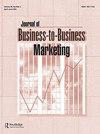主动还是被动?中国营销渠道依赖行为研究
IF 2.5
4区 管理学
Q3 BUSINESS
引用次数: 0
摘要
摘要目的企业间依赖是营销渠道文献中的一个基本概念。它在很大程度上影响着营销渠道合作伙伴之间的关系和行为。本研究旨在检验在中国市场营销渠道背景下,主动和被动企业间依赖在前因和效应方面的差异。方法论/方法我们设计了一份问卷,并从制造商和经销商二人组中的制造商那里收集数据。我们在调查中获得了202个有效数据,并用贝叶斯结构方程建模(BSEM)对数据进行了分析。研究结果首先,在制造商和经销商的二元模型中,经销商的重要资源显著诱导制造商的主动依赖,而制造商的主动依存反过来又对制造商的特定资产投资产生积极影响。其次,制造商的特定资产投资正向影响制造商的被动依赖,这种对制造商被动依赖的影响强于经销商重要资源对制造商被动依存的影响。第三,制造商的主动依赖在增加经销商权力方面比制造商的被动依赖更重要。贡献首先,我们明确定义了主动依赖和被动依赖,并测试了这两种类型的依赖在前因和后果方面是否存在差异。此外,我们还建立了一个主动依赖量表,该量表可供未来企业间依赖研究参考。含义营销经理在与合作伙伴打交道时,应该意识到主动和被动的公司间依赖之间的差异。他们还应该认识到,尽管重要资源和特定资产投资都可能改变公司间依赖的结构,但它们的影响可能不同。本文章由计算机程序翻译,如有差异,请以英文原文为准。
Active or Passive? Examination of Dependency Behavior in Marketing Channels in China
ABSTRACT Purpose Inter-firm dependence is a fundamental construct in the literature of marketing channels. It substantially affects the relationships and behaviors between marketing channel partners. This study aims to examine the differences between active and passive inter-firm dependence regarding the antecedents and effects in the context of marketing channels in China. Methodology/Approach We designed a questionnaire and collected data from the manufacturers in manufacturer and dealer dyads. We obtained 202 valid data in the survey and analyzed the data with Bayesian structural equation modeling (BSEM). Findings First, in a manufacturer and dealer dyad, dealer’s important resources significantly induce active dependence from the manufacturer, and manufacturer’s active dependence, in turn, has a positive impact on manufacturer’s specific asset investments. Second, manufacturer’s specific asset investments positively affect manufacturer’s passive dependence, and this impact on manufacturer’s passive dependence is stronger than the impact of dealer’s important resources on manufacturer’s passive dependence. Third, the manufacturer’s active dependence plays a more important role in increasing dealer’s power than manufacturer’s passive dependence. Contribution Primarily, we clearly define active and passive dependence, and test whether differences exist between these two types of dependence regarding the antecedents and consequences. Besides, we develop a scale of active dependence which may be referred to in the future studies of inter-firm dependence. Implications Marketing managers should be aware of differences between active and passive inter-firm dependence when dealing with partners. They should also recognize that although both important resources and specific asset investments could change the structure of inter-firm dependence, their effects may be different.
求助全文
通过发布文献求助,成功后即可免费获取论文全文。
去求助
来源期刊
CiteScore
2.20
自引率
35.70%
发文量
22
期刊介绍:
The Journal of Business-to-Business Marketing® encourages diversity in approaches to business marketing theory development, research methods, and managerial problem solving. An editorial board comprised of outstanding, internationally recognized scholars and practitioners ensures that the journal maintains impeccable standards of relevance and rigorous scholarship. The Journal of Business-to-Business Marketing features: •basic and applied research that reflects current business marketing theory, methodology, and practice •articles from leading researchers covering topics of mutual interest for the business and academic communities

 求助内容:
求助内容: 应助结果提醒方式:
应助结果提醒方式:


